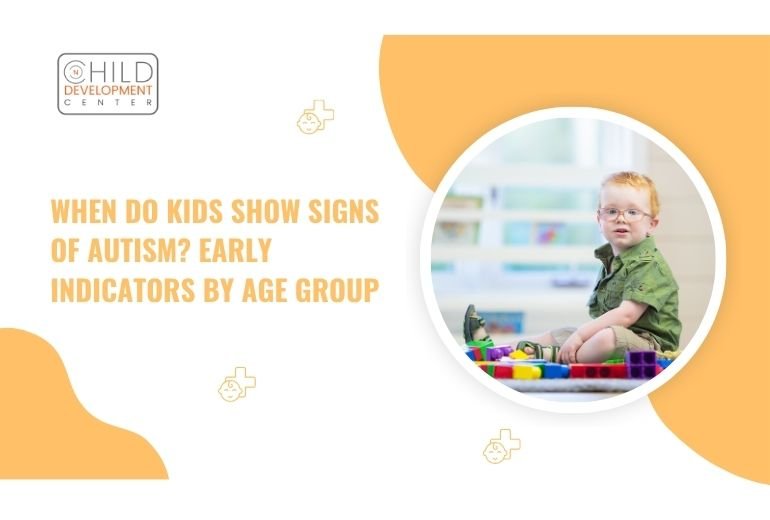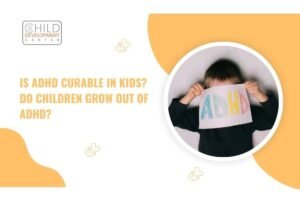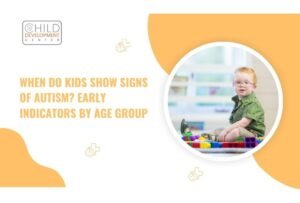When do Kids Show Signs of Autism? Early Indicators by Age Group

Autism spectrum disorder (ASD) is a neurodevelopmental condition that affects social skills, communication, behavior, and learning.
The earlier the signs are identified, the sooner a child can receive the necessary support and interventions, which can significantly improve their development.
So, when do kids show signs of autism? The answer can vary, as autism manifests differently in each child. However, there are common early indicators that parents and caregivers should be aware of.
In this blog, we’ll guide you through the early warning signs of autism and how they manifest across various age groups.
When do kids show signs of autism by age group?
Infants (0-12 months)
In the early months, signs of autism can be subtle, but some behaviors to watch for include:
- Lack of eye contact: Babies typically make eye contact by 3 months, but infants with autism may avoid eye contact altogether.
- Limited social smiling: By 6 months, most babies smile in response to faces and social interactions. Infants with autism may show less interest in social smiles.
- Delayed response to name: By 6 months, babies should begin to respond to their name. If a baby consistently doesn’t respond or seems unaware when called, it could be an early sign of autism.
- Limited gestures: Most babies begin using hand gestures like pointing or waving by 9 months. A lack of these gestures might indicate a developmental delay.
Toddlers (1-3 years)
As children approach toddlerhood, more obvious signs of autism may emerge. By the time kids are around 18-24 months, you may notice:
- Delayed speech and language development: Many toddlers with autism may not speak at all by the age of 2, while others may have difficulty with conversations.
- Repetitive behaviors: Children with autism may start to engage in repetitive activities, such as hand-flapping, rocking, or spinning objects. These behaviors often emerge around age 2.
- Limited social engagement: A toddler with autism may prefer solitary play over interacting with others. They may also have difficulty understanding social cues or playing pretend games.
- Narrow interests or routines: A child with autism may exhibit intense interest in a specific toy or activity, and may become upset if their routine is disrupted.
Preschoolers (3-5 years)
By the preschool years, more defined behavior patterns related to autism may be evident. When do kids show signs of autism in this stage? Key behaviors include:
- Difficulty with pretend play: Children with autism may struggle with imaginative or pretend play, often preferring repetitive activities or sticking to routines.
- Difficulty with peer interaction: Preschoolers with autism may find it challenging to make friends or understand social rules like taking turns or sharing.
- Sensory sensitivities: Many children with autism have sensitivity to lights, sounds, textures, and smells. They may become overwhelmed or distressed by stimuli that other children can tolerate.
- Speech and communication delays: While some children with autism may develop language skills at a normal pace, others may experience speech delays or struggle with understanding language nuances like jokes or sarcasm.
School-aged children (6-12 years)
As children enter school, the signs of autism may become more apparent in social and academic settings.
- Social Isolation: School-age children with autism may have trouble making friends or understanding social norms, which can lead to feelings of isolation.
- Difficulty with Nonverbal Communication: Understanding facial expressions, body language, or tone of voice may be difficult for children with autism, leading to misinterpretations or awkward interactions.
- Academic Challenges: Children with autism may excel in certain areas, such as math or memorization, but struggle with others, like reading comprehension or problem-solving, due to their difficulty with abstract thinking.
- Repetitive or Ritualistic Behaviors: Some school-age children may continue to engage in repetitive behaviors, like arranging objects in a specific order or following rigid routines.
Recent Post

Is ADHD Curable in Kids? Do Children Grow Out of ADHD?
Is ADHD Curable in Kids? Do Children Grow Out of ADHD? ADHD is a common concern among parents and caregivers, often leading to the question:

When do kids show signs of autism? Early indicators by age group
When do Kids Show Signs of Autism? Early Indicators by Age Group Autism spectrum disorder (ASD) is a neurodevelopmental condition that affects social skills, communication,

Is autism genetic or environmental? Exploring the key influences
Is Autism Genetic or Environmental? Exploring the Key Influences If you’ve ever wondered if is autism genetic? You’re not alone. Many families navigating an autism
Contact Us
Visit CDC for Autism Treatment in Dubai
Recognizing the early signs of autism is crucial in fostering a supportive environment for your child.
At the Child Development Center (CDC) in Dubai, we specialize in providing expert, compassionate care tailored to each child’s unique needs. As Dubai’s premier destination for children’s neurological, developmental, and behavioral care, CDC brings together a globally trained team of pediatric neurologists, therapists, psychologists, psychiatrists, and allied health professionals.
Frequently Asked Questions
Autism is a developmental condition that impacts how kids communicate, interact, and behave. It can range from mild to more noticeable symptoms and varies widely from child to child.
Signs of autism often appear by 12 to 24 months, though some children may show signs earlier or later. Parents often ask when do kids show signs of autism, and early signs can sometimes be noticed as early as 6 months, depending on the child.
The first signs of autism include lack of eye contact, delayed speech, not responding to their name, and limited gestures like pointing or waving.
Autism is thought to be the result of a mix of genetic and environmental influences that affect brain development early in life. Early diagnosis and intervention are key to supporting a child’s developmental needs.
